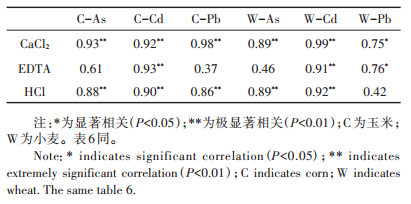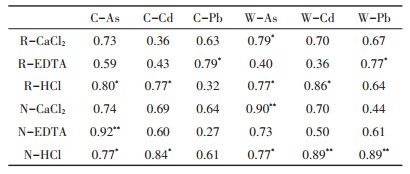2. 南京大学现代分析中心, 南京 210093
2. Center of Material Analysis, Nanjing University, Nanjing 210093, China
土壤重金属污染是我国面临的严重环境问题之一[1-3],因而重金属污染土壤的治理和修复一直是备受关注的环境研究热点之一[4-5]。目前,由农林废弃物等富含生物质的原料碳化而制备的生物炭作为土壤修复剂和土壤改良剂的研究受到广泛的关注[6-7]。实验室植物盆栽实验和现场大田实验的研究表明生物炭能有效地降低土壤中重金属的迁移性和植物有效性,从而固定土壤中重金属元素,因而有希望成为一种新型的低成本的修复剂[8-10]。生物炭修复重金属污染土壤的研究主要关注土壤理化性质、营养元素和重金属的生物有效性及植物富集等,少量研究涉及植物的根际与非根际重金属形态的分析比较,而生物炭如何影响植物根际土壤与本体土壤中重金属的迁移性和植物有效性的研究对于探明生物炭固定污染土壤重金属的效果和降低植物重金属富集机理等具有重要的理论和实际意义[11-14]。因而相关研究有待进一步开展。此外,根袋盆栽植物实验是植物根际和非根际效应比较研究的经典方法[15]。采集植物根际土壤与本体土壤,通过中性盐溶液、稀酸溶液、有机螯合剂溶液和缓冲盐溶液等提取剂提取土壤中不同赋存形态的重金属,探讨土壤中重金属的迁移性和植物有效性,有助于科学评估生物炭的修复效果[16-17]。
小麦和玉米是我国两种常见的农作物,其重金属富集可能直接影响居民身体健康,因而降低其有害元素的富集研究具有重要意义。本文以理化性质不同的废纸、木屑以及脱水污泥等3种常见原材料制备生物炭,通过实验室根袋盆栽试验来研究生物炭的施用对这两种植物幼苗根际及非根际土壤中有害元素生物有效性的影响[18-19],为评价生物炭修复重金属污染土壤提供科学参考。
1 材料与方法 1.1 实验材料实验小麦(Triticum aestivum L.cv. Nongmai88,农麦88)和玉米种子(Zea mays L. cv. Suyu44,苏玉44)购于种子公司。实验土壤采集于南京市栖霞区铅锌矿周边的农田,袋装运回实验室后自然风干,除去杂物和较大石块后过2 mm筛,置于聚乙烯塑料自封袋中备用。按照《土壤农业化学分析方法》中的电位法和水合热重铬酸钾氧化-比色法分别测定实验土壤的pH和有机质[20]。土壤pH为6.81;有机质含量为5.52%。有害元素As、Cd和Pb的总量[经HNO3-HClO4-HF消煮后,用电感耦合等离子体直读光谱仪(ICP-OES,Optima5300OES,PerkinElmer,USA)测定],分别为158、37.9、2975 mg·kg-1。参照国家土壤环境质量标准(GB 15618—2018),实验土壤中As、Cd、Pb的含量均超过了土壤环境风险管制值,说明实验土壤中As、Cd、Pb的污染比较严重。
分别收集废弃包装纸盒、锯木厂木屑、市政污水处理厂的脱水污泥等原材料。将包装纸盒剪碎、清洗,木屑也一并清洗,然后置于温度为85 ℃的烘箱中36 h充分干燥。将干燥的脱水污泥、包装纸盒碎片和木屑分别放置在管式炉中,通入N2,在600 ℃限氧的条件下裂解2 h,待自然冷却之后将热解制备的生物炭取出研磨,过2 mm筛后装袋备用。制备废纸基生物炭、木屑基生物炭和污泥基生物炭分别记为PB、WB和SB。这三种生物炭的基本理化性质见表 1。
|
|
表 1 三种生物炭的比表面积、孔径分布、元素组成、灰分以及产率 Table 1 BET characteristics, elemental compositions, ash contents (AC), and yields of three biochars |
实验设置每100 g土壤分别施用0.5 g和5 g共两个梯度的生物炭施用量,混合均匀,同时以不加生物炭土壤作为对照组。以聚乙烯塑料杯作为盆栽实验容器,每份分别装入100 g上述土壤,备用。每种处理分别设置5个平行样。用300目尼龙网按文献方法制作根袋[21],待用。
将小麦和玉米种子洗净,置于托盘中湿润的脱脂纱布中,置于生物光照培养箱中培养并保持湿润。待种子发芽后开始移植。分别将萌发的小麦种子和玉米种子移植到根袋中,每份小麦种子植入5颗,每份玉米种子植入8颗,加少许土壤覆盖。通过称重法加水,保持田间持水量的40%~50%。将所有容器移到生物光照培养箱中进行培养,设置温度为24.5 ℃,每日光照周期为12 h/12 h。用称重法每日向每份盆栽植物施加自来水以保持土壤的湿润和植物的正常生长。
培养4周后收割小麦和玉米幼苗。将所有小麦和玉米幼苗移出根袋,小心去除根际土壤,用自来水清洗干净,再用超纯水清洗。放在烘箱中65 ℃下烘干12 h。将烘干后小麦和玉米幼苗的根和茎叶分开,分别装于聚乙烯塑料自封袋备用。分别将小麦和玉米根袋内的根际土和根袋外的非根际土取出,在85 ℃的条件下烘干24 h、研磨过100目筛,装于聚乙烯塑料自封袋备用。
1.3 分析方法植物样品用硝酸-高氯酸法进行消解[22-23]。称取0.100 g根,置于25 mL的烧杯中,分别加入3 mL硝酸和1 mL高氯酸,电热板加热消解。同时设置试剂空白。消解完成后用5%硝酸溶液定容至10 mL,冰箱保存,待测。土壤样品中生物有效态有害元素分别用3种不同的提取方法提取:用浓度为0.01 mol·L-1的CaCl2溶液提取水溶态有害元素[24];用浓度为0.05 mol·L-1的EDTA溶液提取水溶态、可交换态和部分有机结合态有害元素[25];用浓度为1 mol·L-1的稀HCl溶液提取水溶态、可交换态、碳酸盐结合态以及大量的铁锰氧化物结合态和有机结合态有害元素[26]。称取1.000 g根际土和非根际土,分别置于15 mL的离心管中,分别加入10 mL 0.01 mol·L-1 CaCl2溶液、0.05 mol· L-1 EDTA溶液和1 mol·L-1HCl溶液。同时设置空白对照组。室温下摇动10 h,离心、过滤。收集滤液,冰箱保存,待测。利用上述ICP-OES分析植物和土壤样品中As、Cd、Pb的浓度。不同处理组间的方差多重比较(Post hoc multiple comparisons)采用LSD(Least-significant difference)方法;根际和非根际土壤中有效态含量方差分析采用Paired-samples t test;根际和非根际土壤中有效态含量及其与植物根系富集量相关分析采用Pearson相关分析。所有统计分析由SPSS 16.0完成。
2 结果与讨论 2.1 生物炭对小麦和玉米幼苗根际土和非根际土中有害元素迁移性的影响小麦和玉米幼苗根际和非根际土壤中生物有效态有害元素提取量分别见表 2和表 3。从表 2和表 3可以看出,小麦和玉米幼苗根际和非根际土壤中有效态As、Cd和Pb的含量高低顺序为稀HCl提取态 > EDTA提取态 > CaCl2提取态。这是因为CaCl2提取态主要为水溶态有害元素[24];EDTA提取态包含水溶态、可交换态和部分有机结合态有害元素[25];稀HCl提取态包括水溶态、可交换态、碳酸盐结合态有害元素,以及大量的铁锰氧化物结合态和有机结合态有害元素[26]。
|
|
表 2 小麦幼苗根际土壤和非根际土壤生物有效态有害元素提取量(mg·kg-1) Table 2 Bioavailable contents in the rhizosphere and non-rhizosphere soil of wheat seedlings (mg·kg-1) |
|
|
表 3 玉米幼苗根际土壤和非根际土壤生物有效态有害元素提取量(mg·kg-1) Table 3 Bioavailable contents in the rhizosphere and non-rhizosphere soil of corn seedlings (mg·kg-1) |
与对照组相比,生物炭处理组小麦和玉米幼苗根际和非根际土壤中生物有效态As、Cd和Pb的提取量有着不同程度的降低。如施用5%PB时,小麦幼苗根际土壤中EDTA提取态As、Pb和Cd的提取量分别降低了38%、19%和36%,非根际土壤中EDTA提取态As、Pb和Cd的提取量分别降低了22%、34%和20%;玉米幼苗根际土壤中EDTA提取态As、Pb和Cd的提取量分别降低了25%、19%和9.2%,非根际土壤中EDTA提取态As、Pb和Cd的提取量分别降低了51%、20%和9.7%(表 2和表 3)。多重比较统计分析表明,与对照组相比,5%施用组3种生物炭均能显著的降低小麦和玉米幼苗根际和非根际土壤中CaCl2提取态、EDTA提取态和稀HCl提取态有效态有害元素含量。部分0.5%施用组生物炭显著降低小麦和玉米幼苗根际和非根际土壤中CaCl2提取态、EDTA提取态和稀HCl提取态有效态有害元素含量。因而与对照组相比,生物炭的施用量从0.5%增加到5%,小麦幼苗根际和非根际土壤中有效态As、Cd和Pb的含量显著降低。5%施用量能降低水溶态、可交换态、碳酸盐结合态、及部分铁锰氧化物结合态和有机结合态As、Cd和Pb的含量。这与文献报道相一致[27-28]。如施用玉米秸秆炭使污染土壤中交换态Cd的含量降低[29];5%稻草秸秆分别降低土壤中34.5%、50.1%、52.5%和52.1%有效态Cd、Cu、Pb和Zn的含量[30]。毛懿德等[31]盆栽实验表明,与对照相比,0.1%和1.0%的竹炭及柠条生物炭处理可使交换态Cd含量分别降低4.99%、5.44%和9.44%、16.64%。崔立强等[32]研究发现,加入生物炭可使污染土壤Pb酸溶态、还原态和氧化态组分显著降低并向残渣态转化。李季等[33]室内水稻培养法研究发现,生物炭处理导致土壤Sb的生物可利用性比对照显著降低了20%。在本研究中,5%的生物炭施用量可显著降低小麦和玉米幼苗根际和非根际土壤中生物有效态As、Cd和Pb的含量。3种理化性质不同的生物炭处理组土壤中有效态As、Cd和Pb含量变化与提取剂(CaCl2、EDTA和稀HCl)相关,但未表现出一致性的规律(表 2和表 3)。此外,3种生物炭对有效态的影响存在较大的差异(表 2和表 3)。例如:5%生物炭处理组小麦幼苗根际土壤中EDTA提取态As的PB处理组显著低于WB和SB,而非根际组则不同(表 2)。因而不仅与生物炭性质有关,还与提取的As、Cd和Pb提取剂及根际效应有关,但也难以总结出一致性的规律(表 2和表 3)。
以往研究表明[34-35],植物根际效应是影响土壤重金属生物有效性与植物重金属富集的一个重要因素。将根际和非根际土壤中3种方法提取的有效态含量进行Paired-samples t test方差分析(表 2和表 3)和Pearson相关分析(表 4)。Paired-samples t test分析结果表明,总体而言小麦和玉米幼苗根际与非根际土壤中CaCl2提取态As、Cd和Pb的含量无显著差异(表 2和表 3)。小麦和玉米幼苗根际与非根际土壤中EDTA提取态和稀HCl提取态Cd含量无显著差异(表 2和表 3)。小麦幼苗非根际土壤中EDTA提取态Pb除对照组外显著高于其根际土壤;而EDTA提取态As含量除SB处理组外显著高于其根际土壤。小麦幼苗非根际土壤中稀HCl提取态Pb除5%SB处理组外显著高于其根际土壤;而除5%PB处理组外根际土壤与非根际土壤中稀HCl提取态As的含量无显著差异(表 2)。玉米幼苗根际土壤中EDTA提取态Pb除5%WB组外显著高于其非根际土壤;3种5%生物炭处理组玉米幼苗根际土壤中EDTA提取态As的含量显著高于其非根际土壤(表 3)。玉米幼苗根际土壤中稀HCl提取态Pb除0.5%WB和0.5%SB组外显著高于其非根际土壤;而根际土壤与非根际土壤中稀HCl提取态As的含量无显著差异(表 3)。Pearson相关分析表明,小麦和玉米幼苗根际土壤与非根际土壤中CaCl2提取态As、Cd、Pb的含量呈显著相关;EDTA提取态玉米Cd和小麦Cd、Pb的含量呈显著相关;除小麦Pb外,稀HCl提取态As、Cd和Pb的含量呈显著相关(表 4)。这些表明,生物炭处理对根际与非根际土壤中水溶态As、Cd和Pb无显著影响。总体而言,生物炭处理明显降低非根际土壤中As、Cd和Pb的有效态含量。
|
|
表 4 小麦和玉米幼苗根系根际与非根际土壤提取态有害元素含量的相关系数 Table 4 Pearson correlation coefficients of extractable fractions in the rhizosphere and non-rhizosphere soil |
小麦和玉米幼苗根系As、Cd和Pb的含量见表 5。从表 5可以看出,小麦和玉米幼苗根系对于As、Cd和Pb的富集具有明显的植物种属差异。如玉米幼苗根系中As和Pb的含量明显高于小麦幼苗根系的富集量,但两种植物根系Cd含量无显著差异。与对照组相比,施用生物炭均能不同程度地降低小麦和玉米幼苗根系As、Cd和Pb的含量(表 5),并且随着生物炭施用量从0.5%增加到5%,小麦和玉米幼苗根系中As、Cd和Pb含量也明显降低。如生物炭施用量为5%时,小麦和玉米幼苗根系中As、Cd和Pb含量显著低于对照组(表 5)。与对照组相比,施用5%WB的小麦幼苗根系中Pb含量降低最多,达到了74%;施用5%SB的小麦幼苗根系中As和Cd含量降低最多,分别达到了71%和40%;施用WB的玉米幼苗根系中As和Pb含量降低最多,分别达到了69%和58%;施用SB的玉米幼苗根系中Cd含量降低最多,达到了61%。由此可见,不同生物炭的施用对作物根系有害元素的富集具有不同的影响效果。
|
|
表 5 小麦和玉米幼苗根系有害元素含量(mg·kg-1) Table 5 Toxic element contents of wheat and corn seedling roots (mg·kg-1) |
小麦和玉米幼苗根系有害元素含量与根际和非根际土壤提取态含量的相关分析表明,玉米幼苗根际土壤中CaCl2提取态As、Cd、Pb含量和小麦幼苗根际土壤中CaCl2提取态Cd、Pb含量与根系中相应的富集量无显著相关(表 6)。从表 6还可以看出,只有部分处理组EDTA提取态和稀HCl提取态As、Cd或Pb含量与玉米小麦幼苗根系中相应的富集量有显著相关。因而,难以通过单一提取态含量的分析来预测生物炭处理污染土壤中As、Cd和Pb的植物有效性。文献报道生物炭的施用可以降低植物有害元素的富集[36-39],但其作用机理尚不清晰。一般认为,生物炭的加入改变土壤理化性质,如提高土壤pH、增加有机质等[27],从而降低有害元素生物有效性,减轻其生物富集。但通过田间水稻种植试验,Chen等[40]发现生物炭的施用对当季水稻的Cd含量没有显著影响。因而,相关研究有待进一步深入。
|
|
表 6 小麦和玉米幼苗根系有害元素含量与根际和非根际土壤提取态含量的相关系数 Table 6 Pearson correlation coefficients between As, Cd and Pb in the roots of wheat and corn seedling and their extractable fractions in soil |
(1)施用生物炭可以降低小麦和玉米幼苗根际土壤和非根际土壤中有害元素的生物有效性。但根际土壤和非根际土壤中水溶态(CaCl2提取态)As、Cd和Pb的含量无显著差异。不同原料所制备的生物炭对As、Cd和Pb的固定效果存在明显差异。
(2)施用生物炭可以有效降低小麦和玉米幼苗根系As、Cd和Pb的富集量,且随着生物炭施用量的增加有害元素富集量的降低更明显。
| [1] |
Du Y, Hu X F, Wu X H, et al. Affects of mining activities on Cd pollution to the paddy soils and rice grain in Hunan province, Central South China[J]. Environmental Monitoring & Assessment, 2013, 185(12): 9843-9856. |
| [2] |
Soares M A, Quina M J, Quinta-Ferreira R M. Immobilisation of lead and zinc in contaminated soil using compost derived from industrial eggshell[J]. Journal of Environmental Management, 2015, 164(12): 137-145. |
| [3] |
苏耀明, 陈志良, 雷国建, 等. 多金属矿区土壤重金属垂向污染特征及风险评估[J]. 生态环境学报, 2016, 25(1): 130-134. SU Yao-ming, CHEN Zhi-liang, LEI Guo-jian, et al. Vertical pollution characteristic and ecological risk assessment of heavy metal of soil profiles in polymetallic ore mine[J]. Ecology and Environmental Sciences, 2016, 25(1): 130-134. |
| [4] |
Liu G, Tao L, Liu X, et al. Heavy metal speciation and pollution of agricultural soils along Jishui River in non-ferrous metal mine area in Jiangxi Province, China[J]. Journal of Geochemical Exploration, 2013, 132(3): 156-163. |
| [5] |
Zhang C, Li Z, Yang W, et al. Assessment of metals pollution on agricultural soil surrounding a lead-zinc mining area in the Karst region of Guangxi, China[J]. Bull Environ Contam Toxicol, 2013, 90(6): 736-741. DOI:10.1007/s00128-013-0987-6 |
| [6] |
陶雪, 杨琥, 季荣, 等. 固定剂及其在重金属污染土壤修复中的应用[J]. 土壤, 2016, 48(1): 1-11. TAO Xue, YANG Hu, JI Rong, et al. Stabilizers and their applications in remediation of heavy metal-contaminated soil[J]. Soils, 2016, 48(1): 1-11. |
| [7] |
Rumble H, Gange A C. Microbial inoculants as a soil remediation tool for extensive green roofs[J]. Ecological Engineering, 2017, 102: 188-198. DOI:10.1016/j.ecoleng.2017.01.025 |
| [8] |
Jiang J, Xu R K, Jiang T Y, et al. Immobilization of Cu(Ⅱ), Pb(Ⅱ) and Cd(Ⅱ) by the addition of rice straw derived biochar to a simulated polluted Ultisol[J]. Journal of Hazardous Materials, 2012, 229-230(5): 145-150. |
| [9] |
高瑞丽, 朱俊, 汤帆, 等. 水稻秸秆生物炭对镉、铅复合污染土壤中重金属形态转化的短期影响[J]. 环境科学学报, 2016, 36(1): 251-256. GAO Rui-li, ZHU Jun, TANG Fan, et al. Fractions transformation of Cd, Pb in contaminated soil after short-term application of rice straw biochar[J]. Acta Scientiae Circumstantiae, 2016, 36(1): 251-256. |
| [10] |
王丹丹, 林静雯, 丁海涛, 等. 牛粪生物炭对重金属镉污染土壤的钝化修复研究[J]. 环境工程, 2016, 34(12): 183-187. WANG Dan-dan, LIN Jing-wen, DING Hai-tao, et al. Immobilization of cadmium in soils by dairy dung biochar[J]. Environmental Engineering, 2016, 34(12): 183-187. |
| [11] |
武玉, 徐刚, 吕迎春, 等. 生物炭对土壤理化性质影响的研究进展[J]. 地球科学进展, 2014, 29(1): 68-79. WU Yu, XU Gang, LÜ Ying-chun, et al. Effects of biochar amendment on soil physical and chemical properties:Current status and knowledge gaps[J]. Advances in Earth Science, 2014, 29(1): 68-79. |
| [12] |
Gul S, Whalen J K, Thomas B W, et al. Physico-chemical properties and microbial responses in biochar-amended soils:Mechanisms and future directions[J]. Agriculture Ecosystems & Environment, 2015, 206: 46-59. |
| [13] |
Yang X, Liu J, Mcgrouther K, et al. Effect of biochar on the extractability of heavy metals(Cd, Cu, Pb, and Zn) and enzyme activity in soil[J]. Environ Sci Pollut Res Int, 2016, 23(2): 974-984. |
| [14] |
李卓瑞, 韦高玲. 不同生物炭添加量对土壤中氮磷淋溶损失的影响[J]. 生态环境学报, 2016, 25(2): 333-338. LI Zhuo-rui, WEI Gao-ling. Effects of biochar with different additive amounts on the leaching loss of nitrogen and phosphorus in soils[J]. Ecology and Environmental Sciences, 2016, 25(2): 333-338. |
| [15] |
Romualdo J, Lima S, Silva W D M, et al. Effect of biochar on physicochemical properties of a sandy soil and maize growth in a greenhouse experiment[J]. Geoderma, 2018, 319(1): 14-23. |
| [16] |
张丽, 侯萌瑶, 安毅, 等. 生物炭对水稻根际微域土壤Cd生物有效性及水稻Cd含量的影响[J]. 农业环境科学学报, 2017, 36(4): 665-671. ZHANG Li, HOU Meng-yao, AN Yi, et al. Effects of biochar on Cd bioavailability in rhizosphere microenvironment of cadmium-polluted paddy and Cd content in rice[J]. Journal of Agro-Environment Science, 2017, 36(4): 665-671. |
| [17] |
Ahmed A, Kurian J K, Raghavan V. Biochar influences on agricultural soils, crop production and the environment:A review[J]. Environmental Reviews, 2016, 24(4): 495-502. DOI:10.1139/er-2016-0008 |
| [18] |
Beesley L, Marmiroli M. The immobilisation and retention of soluble arsenic, cadmium and zinc by biochar[J]. Environmental Pollution, 2011, 159(2): 474-480. |
| [19] |
Cao X, Ma L, Liang Y, et al. Simultaneous immobilization of lead and atrazine in contaminated soils using dairy-manure biochar[J]. Environmental Science & Technology, 2011, 45(11): 4884-4889. |
| [20] |
鲁如坤. 土壤农业化学分析方法[M]. 北京: 中国农业科技出版社, 2000: 12-13. LU Ru-kun. Methods of soil agricultural chemical analysis[M]. Beijing: China Agricultural Science and Technology Press, 2000: 12-13. |
| [21] |
Mcgrath S P, Shen Z G, Zhao F J. Heavy metal uptake and chemical changes in the rhizosphere of Thlaspi caerulescens and Thlaspi ochroleucum grown in contaminated soils[J]. Plant & Soil, 1997, 188(1): 153-159. |
| [22] |
徐珑珀, 赵向阳, 杨浩, 等. 不同消解方法对HG-AFS测定植物样品硒含量的影响[J]. 中国测试, 2015, 41(3): 61-64. XU Long-bo, ZHAO Xiang-yang, YANG Hao, et al. The influence of different digestion methods for the determination of selenium in plant samples by HG-AFS[J]. China Measurement & Test, 2015, 41(3): 61-64. |
| [23] |
Masson P, Dalix T. Comparison of open digestion methods for the determination of rare earth elements in plant samples by ICP-MS[J]. Communications in Soil Science & Plant Analysis, 2016, 47(16): 1866-1874. |
| [24] |
Novozamsky I, Lexmond T M, Houba V J G. A single extraction procedure of soil for evaluation of uptake of some heavy metals by plants[J]. International Journal of Environmental Analytical Chemistry, 1993, 51(1/2/3/4): 47-58. |
| [25] |
Wear J I, Evans C E. Relationship of zinc uptake by corn and sorghum to soil zinc measured by three extractants[J]. Soil Science Society of America Journal, 1968, 32(4): 543-546. DOI:10.2136/sssaj1968.03615995003200040035x |
| [26] |
Snape I, Scouller R C, Stark S C, et al. Characterisation of the dilute HCl extraction method for the identification of metal contamination in Antarctic marine sediments[J]. Chemosphere, 2004, 57(6): 491-504. DOI:10.1016/j.chemosphere.2004.05.042 |
| [27] |
Zhang X, Wang H, He L, et al. Using biochar for remediation of soils contaminated with heavy metals and organic pollutants[J]. Environmental Science & Pollution Research, 2013, 20(12): 8472-8483. |
| [28] |
Lahori A H, Guo Z Y, Zhang Z Q, et al. Use of biochar as an amendment for remediation of heavy metal-contaminated soils:Prospects and challenges[J]. Pedosphere, 2017, 27(6): 991-1014. DOI:10.1016/S1002-0160(17)60490-9 |
| [29] |
高译丹, 梁成华, 裴中健, 等. 施用生物炭和石灰对土壤镉形态转化的影响[J]. 水土保持学报, 2014, 28(2): 258-261. GAO Yi-dan, LIANG Cheng-hua, PEI Zhong-jian, et al. Effects of biochar and lime on the fraction transform of cadmium in contaminated soil[J]. Journal of Soil and Water Conservation, 2014, 28(2): 258-261. |
| [30] |
刘晶晶, 杨兴, 陆扣萍, 等. 生物质炭对土壤重金属形态转化及其有效性的影响[J]. 环境科学学报, 2015, 35(11): 3679-3687. LIU Jing-jing, YANG Xing, LU Kou-ping, et al. Effect of bamboo and rice straw biochars on the transformation and bioavailability of heavy metals in soil[J]. Acta Scientiae Circumstantiae, 2015, 35(11): 3679-3687. |
| [31] |
毛懿德, 铁柏清, 叶长城, 等. 生物炭对重污染土壤镉形态及油菜吸收镉的影响[J]. 生态与农村环境学报, 2015, 31(4): 579-582. MAO Yi-de, TIE Bo-qing, YE Chang-cheng, et al. Effects of biochar on forms and uptake of cadmium by rapeseed in cadmium-polluted soil[J]. J Ecol Rural Environ, 2015, 31(4): 579-582. |
| [32] |
崔立强, 杨亚鸽, 严金龙, 等. 生物质炭修复后污染土壤铅赋存形态的转化及其季节特征[J]. 中国农学通报, 2014, 30(2): 233-239. CUI Li-qiang, YANG Ya-ge, YAN Jin-long, et al. Speciation and season change characteristic of lead in contaminated soil with biochar amendment[J]. Chin Agric Sci Bull, 2014, 30(2): 233-239. |
| [33] |
李季, 黄益宗, 胡莹, 等. 改良剂对土壤Sb赋存形态和生物可给性的影响[J]. 环境化学, 2015, 34(6): 1043-1048. LI Ji, HUANG Yi-zong, HU Ying, et al. Effect of several amendments on fractionation and bio-accessibility of antimony in contaminated soil[J]. Environ Chem, 2015, 34(6): 1043-1048. |
| [34] |
林琦, 陈怀满, 郑春荣, 等. 根际和非根际土中铅、镉行为及交互作用的研究[J]. 浙江大学学报(农业与生命科学版), 2000, 26(5): 527-532. LIN Qi, CHEN Huai-man, ZHEN Chun-rong, et al. Chemical behavior of Cd, Pb and their interaction in rhizosphere and bulk[J]. Journal of Zhejiang University(Agriculture and Life Sciences), 2000, 26(5): 527-532. DOI:10.3321/j.issn:1008-9209.2000.05.015 |
| [35] |
Wei W, Wei Z, Wang Y, et al. Simultaneous determination of organic acids and nitrate in xylem saps of the hyperaccumulator Alyssum murale by RP-HPLC after solid-phase extraction with nanosized hydroxyapatite[J]. Journal of Chromatographic Science, 2010, 48(10): 840-847. DOI:10.1093/chromsci/48.10.840 |
| [36] |
毕丽君, 侯艳伟, 池海峰, 等. 生物炭输入对碳酸钙调控油菜生长及重金属富集的影响[J]. 环境化学, 2014, 33(8): 1334-1341. BI Li-jun, HOU Yan-wei, CHI Hai-feng, et al. Effect of biochar input on the regulation of calcium carbonate application to rape growth and heavy metal accumulation in contaminated soil[J]. Environmental Chemistry, 2014, 33(8): 1334-1341. |
| [37] |
Xu P, Sun C X, Ye X Z, et al. The effect of biochar and crop straws on heavy metal bioavailability and plant accumulation in a Cd and Pb polluted soil[J]. Ecotoxicology & Environmental Safety, 2016, 132(10): 94-100. |
| [38] |
侯艳伟, 池海峰, 毕丽君. 生物炭施用对矿区污染农田土壤上油菜生长和重金属富集的影响[J]. 生态环境学报, 2014, 23(6): 1057-1063. HOU Yan-wei, CHI Hai-feng, BI Li-jun. Effects of biochar application on growth and typical metal accumulation of rape in mining contaminated soil[J]. Ecology and Environmental Sciences, 2014, 23(6): 1057-1063. DOI:10.3969/j.issn.1674-5906.2014.06.024 |
| [39] |
李衍亮, 黄玉芬, 魏岚, 等. 施用生物炭对重金属污染农田土壤改良及玉米生长的影响[J]. 农业环境科学学报, 2017, 36(11): 2233-2239. LI Yan-liang, HUANG Yu-fen, WEI Lan, et al. Impacts of biochar application on amelioration of heavy metal-polluted soil and maize growth[J]. Journal of Agro-Environment Science, 2017, 36(11): 2233-2239. DOI:10.11654/jaes.2017-0522 |
| [40] |
Chen D, Guo H, Li R Y, et al. Low uptake affinity cultivars with biochar to tackle Cd-tainted rice:A field study over four rice seasons in Hunan, China[J]. Science of the Total Environment, 2016, 541(1): 1489-1498. |
 2019, Vol. 38
2019, Vol. 38








